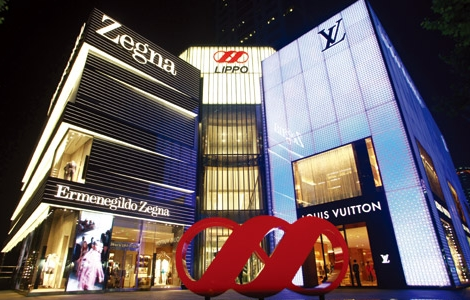双语:国际奢侈品牌在中国的“肮脏小秘密”
 国际奢侈品牌在中国销售的内幕
国际奢侈品牌在中国销售的内幕The dirty little secret among luxury-goods companies is that they have been persistently overcharging their best customers in China。
国际奢侈品牌在中国有个“肮脏小秘密”:中国人已经成为它们最好的顾客,但它们却一直多收中国人的钱。
With Chinese appetite for everything from expensive cars to handbags is starting to moderate, companies that count on the country as a big growth driver may have to do the unthinkable and lower their prices。
随着中国人对于从豪华车到高价手提包的兴趣开始缩减,那些把中国当成最大成长市场的公司可能不得不做他们之前无法想象的事情──开始降价。
A comparison of three models from Mercedes-Benz, Audi NSU.XE and BMW BMW.XE shows that, on average, listed prices of luxury sedans in China are 64% more expensive than similar vehicles sold in the U.S. This looks counterintuitive, considering goods made in China are supposed to be cheaper。
比较一下奔驰、奥迪和宝马三个型号的车的价格可以看到,豪华轿车在中国的价格平均要比同类型车在美国的价格高64%。这有点让人感到匪夷所思,因为“中国制造”本是廉价的代名词。
The listed price of a Mercedes C-Class in China starts at $57, 120, or 62% higher than in the U.S. Similarly, locally made Audi A4 and BMW 3-Series are 54% and 76% more expensive in China, according to Bernstein Research. The gap is even bigger when it comes to imported vehicles。
奔驰C级车在中国的售价是5.7万美元,比美国同类车的价格高62%。根据美国研究机构Bernstein的研究,在中国本土制造的奥迪A4和宝马三系比美国卖的同类车的价格要分别高出54%和76%。如果是进口车的话,那价差会更大。
The makers of the three cars argue vehicles in China include more features. But that alone may not explain the price difference。
汽车公司称,在中国卖的车价格更高是因为配置更齐全。中国的汽车价格还包括了消费税和增值税等税收,而美国卖的车没有这两样税。但就算把这些税都刨掉,这三辆车在中国的售价也还是比在美国高37%,这不能完全用更好的配置来解释。
The high base factor—cars sold in China used to be even more expensive before the country joined the World Trade Organization and started to make cars at home—has bought foreign auto makers time. They had little incentive to lower prices, since demand was so overwhelming. Customers used to have to pay extra if they wanted to get their car early。
在中国加入世界贸易组织和在国内生产合资车以前,车价更高,外国车商也没什么动力降价,因为过去需求实在是太旺盛了。消费者过去要想早点拿到车,还要给加急费。
But that is changing now. There are more models available, and demand has softened. This year may be the turning point. Total sales of Audi, BMW and Mercedes in China rose just 6% in the first quarter, compared with 25% in the fourth quarter. BMW said at the Shanghai auto show it expects China sales growth in the upper single digits, after a 40% jump in 2012.
但现在这个情况有所变化。市场上有更多的车型,而需求开始疲软。今年可能就是转变的开始。今年一季度,奥迪、宝马和奔驰在中国的销量增长6%,比去年四季度的25%明显放缓。宝马公司在上海车展时表示,在去年大增40%后,预计今年中国区的销售增长在5%-10%之间。
'The risks of a price war in China are building, 'said Max Warburton, Bernstein's auto analyst. 'Too many companies are dependent on China right now. Price competition would intensify if sales continue to grow at the current pace.'
Bernstein的汽车分析师Max Warburton认为:一场中国价格战正在酝酿之中,太多公司依赖中国市场,如果销售继续按照现在的速度增长,价格竞争会更激烈。
Fashion companies face the same pressure. LVMH MC.FR shares dropped recently after the company said China sales were 'flattish' in the last year or so. The way to win back price-sensitive Chinese consumers, who are serious bargain hunters even when they shop for a $2, 000 bag, may just be lower prices。
服装企业也面对相同的压力。路易威登(LVMH)最近表示过去一年在中国的销售业绩平平之后,股价应声下跌。中国客户对价格相当敏感,就算他们买一个两千美元的皮包时也是这样,降低价格是争取他们的办法之一。
Luxury-goods makers have always been reluctant to be forthcoming about pricing. But the surge in Chinese overseas travelers has made it harder to keep a secret. The same Gucci Joy Boston handbag was 54% more expensive in China than in France in 2009. The premium widened to 62% in 2012, according to European broker Exane BNP Paribas, even though an appreciating yuan should have made imported goods cheaper。
奢侈品公司一直不愿意让标价完全透明,但中国海外游客的增长,使得他们越来越难以保守价格的秘密。根据法国巴黎银行(Exane BNP Paribas)的调查,2009年同样一款古琦(Gucci) Joy Boston的包在中国的价格要比在法国高54%。而这个溢价在2012年扩大到62%,尽管人民币升值应该让进口产品变得更便宜。
Traditionally, leather and fashion prices are 50% higher in Asia than in Europe. Gucci said the price difference is mainly due to taxes, duties, transportation and currency fluctuations, but those differences explain just 70% of the price differential, according to Luca Solca, Exane's luxury-goods sector head. Mr. Solca said he wouldn't be surprised if the premium narrows more in response to slowing demand growth。
一般来说,皮革和时尚产品在亚洲要比欧洲贵50%。古琦说这个差别主要是因为税收、运输和汇率变化。但巴黎银行的奢侈品研究主管Luca Solca认为,这些只能解释70%的价格差别,如果销售增幅继续下滑,这个溢价很有可能缩减。
Some companies have started to narrow the price gap to entice consumers to shop at home more. The differential between Beijing and Paris for Louis Vuitton products fell to about 30% this year from 50% in 2012, the company said。
有些公司已经开始减少溢价,以吸引消费者更多留在中国国内消费。比如路易威登在北京和巴黎的价格,就从去年50%的溢价,下降到今年的30%左右。
Luxury goods sold in Japan used to sport a premium, too, but that has shrunk as demand slowed, said Aaron Fischer, head of consumer research at CLSA. The 'Japan premium' on the Louis Vuitton Speedy 30 handbag was cut in half in the past three years to 24% in 2012, according to Exane BNP Paribas。
里昂证券(CLSA)的消费研究主管Aaron Fischer指出,奢侈品公司过去在日本也有溢价,但随着需求疲软,溢价开始缩减。根据巴黎银行的数据,在过去三年内,路易威登的Speedy 30手提包的“日本溢价”缩小了一半至24%。
Lower prices in luxury-goods makers' most lucrative market will bring pain. A 10% price cut for Mercedes, Audi and BMW means profit per car sold in China will be a third lower, assuming production costs in China are the same as elsewhere in the world。
在奢侈品生产商利润最丰厚的市场降价,会给他们带来痛苦。如果奔驰、奥迪和宝马的车价下降10%,同时假定在中国制造车的成本和其他地方一样,那么他们在中国销售每辆车的利润将下降三分之一。但从长远来说,为了自己的品牌、投资者和客户,奢侈品公司最好还是向现实低头。
- 第一夫人引发本土品牌时尚热(双语)2013-03-27 13:57
- 毕业季:网络销售比跳蚤市场更赚钱2012-06-15 11:16
- 大学生摆摊论“斤”卖书 一天销售额高达两万元2011-04-06 16:04
- 新闻英语:韩寒《独唱团》“销售火爆”2010-07-07 12:10
- 玩转商务英文--超级实用销售英语20句2006-05-11 18:57
